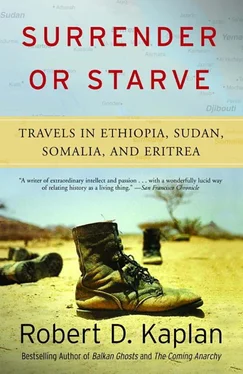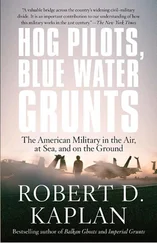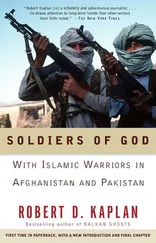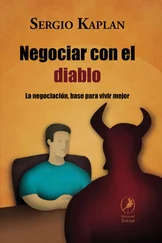But the politics weren’t only of a Sudanese making. There was stalling by Washington, too. Officials in the State Department and in USAID knew that even the most ambitious cross-border project could not get food into many contested areas of south Eritrea and central and eastern Tigre as easily as a Dergue-approved initiative operating from Addis Ababa could, mainly because the distances were shorter and the roads better. Also, the Reagan administration, hoping that the famine would provide an opportunity to wean Ethiopia away from the Soviet Union, did not want to alienate Mengistu before at least giving him a chance to approve a feeding program across guerrilla lines from his side of the trenches. Although only food was to be transported by ERA and REST, food could be a strategic weapon in guerrilla societies where there is little distinction between fighters and civilians. So the cross-border program was organized in no particular hurry, on the premise that just the threat of it actually being implemented would force Mengistu to cooperate on a similar program run from Addis Ababa.
The strategy bore mixed results. Following a midwinter meeting in Geneva between Vice President George Bush and representatives of the Ethiopian government, approval for a so-called northern initiative was given. The New York–based Catholic Relief Services was to move 25,000 tons of grain a month into Eritrea, while World Vision, a California-based Protestant charity, was to transport a similar amount of food into Tigre. The RRC pledged to do nutritional surveys in order to identify the needy in frontline areas. But as one donor agency official told me, the surveys were done “either incompletely or not at all.” It took several months of further negotiations with the Dergue before the trucks began rolling out of Addis Ababa and the ports of Assab and Massawa. The attitude of the Marxist TPLF constituted another hindrance. Not long after the operation finally got under way, the Tigre side of it ground to a halt in early March 1986 after the TPLF killed two Ethiopian employees of World Vision in the town of Alamata in southern Tigre. The Tigrean guerrillas did not want any people from the government side coming into their area. Although the dead Ethiopians, both women, worked for a Western relief agency and not for the Dergue, the TPLF made no distinctions. According to an account written by Blaine Harden ( The Washington Post; International Herald Tribune, March 29–30, 1986), both USAID and World Vision officials stated that the killings were deliberate, as the two women were shot in the dining room of a relief compound after they had identified themselves as World Vision employees.
The hostile attitude of the TPLF, the purloining of grain by Dergue soldiers in both Tigre and Eritrea, and the Dergue’s prohibition against U.S. nationals monitoring grain deliveries in contested areas made the task of World Vision and Catholic Relief Services arguably the most difficult and politically sensitive of the entire emergency effort in Sudan and Ethiopia. If the two charities didn’t succeed, it wasn’t because they lacked the will. It is questionable just how much of this food, if any, actually made it to needy areas on the guerrilla side of the trenches. USAID obviously assumed that not much would because at about the same time that the northern initiative became operational, the final go ahead also was given for the cross-border program operating from Sudan in cooperation with ERA and REST. From a humanitarian standpoint, it is hard to find fault with the Reagan administration. Faced with a war situation in a barely accessible region of Africa, the administration did the only thing that could possibly be done—bring food up from both sides of the battle lines in the hope of reaching as many hungry peasants as possible.
Where the administration failed was in its political strategy. As the emergency drew to a close in 1986, the Dergue was as hostile toward the United States as in 1984; some would say even more so. U.S. officials didn’t seem to understand that it was not the famine but the war in Eritrea—and to a lesser extent in Tigre—that held the key to a political shift in Addis Ababa. But because Washington was operating on the basis of outdated assumptions about the Eritrean resistance, it could not construct a bold strategy for prying the Dergue loose from Moscow. Instead, U.S. policy seemed to rest on the hope that despite a $4 billion Soviet arms investment and the influx of several thousand Eastern bloc advisers, who, among other duties, ran Ethiopia’s security services, the Dergue could be bribed away with grain, much of which was going to areas that Mengistu had a strategic interest in starving. It was a naïve hope, not a realistic calculation.
In a world of imperfect choices, where the United States often finds itself supporting regimes and resistance movements of limited caliber, the Eritrean guerrillas would appear to be useful proxies in a “low intensity war” to make Mengistu cry “uncle.” Liberals on Capitol Hill would have fewer complaints about a group whose exemplary treatment of the eight thousand POWs under its charge has been documented by the International Committee of the Red Cross and whose competence in the field of famine relief during the 1984–1986 period is a matter of public record. The only deserved stain on the EPLF’s reputation was the group’s 1987 attacks on famine relief convoys in heavily contested areas of Eritrea. Without trying to justify these unjustifiable actions, it should be stated that almost every day since the late 1970s, MIGs and other Soviet-made planes take off from Ethiopian government airfields and bomb anything that moves in EPLF and Tigrean guerrilla zones, thereby effectively stopping famine convoys from traveling during daytime hours. After a decade of avoiding retaliation, which got the EPLF absolutely no Western recognition in return, the guerrilla organization changed its policy and was condemned around the world for doing exactly what the Dergue attempted on a daily basis. It reminds me of the situation two decades ago in Biafra—as described by Dan Jacobs in The Brutality of Nations —where the international community looked the other way at massive Nigerian government human rights violations but lambasted the Biafran rebels on the few occasions when their behavior was insupportable.
Unlike Nicaragua, no advisers were needed to train an army. The Eritreans have taught themselves to use all the Soviet equipment they have captured; they might even be able to teach the U.S. military a thing or two. In the spring of 1984, for instance, an EPLF attack on the Asmara airbase resulted in the destruction of two Soviet IL-38 MAYS long-range naval reconnaissance planes, thus forcing the Soviets thereafter to do all their monitoring of the U.S. Indian Ocean fleet from bases in South Yemen. Nor would the EPLF require many different kinds of weapon. Western intelligence experts confirm that the guerrillas capture from the Dergue much of what they need with the exception of shoulder-fired antiaircraft guns, which the Dergue doesn’t have available for capture because the EPLF has no aircraft. In few other places would the sale of a few hundred antiaircraft guns have such dramatic effects as in Eritrea. A sale might accomplish more than all the aid to the Nicaraguan, Cambodian, and Angolan rebels combined, and the effects would be primarily and demonstrably humanitarian in nature (another thing liberals would like) because an air cover would allow cross-border relief convoys already being financed by U.S. taxpayers to roll twenty-four hours a day rather than just at night. In addition, there would not be much debate about the likelihood of the EPLF winning because the guerrillas have no pretensions about toppling the Dergue the way the contras do about toppling the Sandanistas or Savimbi’s rebels do about toppling the Marxist Dos Santos regime in Luanda. The EPLF wants to change Eritrea, not Ethiopia, and might even be satisfied with an autonomy agreement like the one under Haile Selassie, provided that this time it was respected. Moreover, there is so much building dissatisfaction inside the Ethiopian military about the war and the Dergue’s exclusive reliance on the Eastern bloc that the EPLF need not even be victorious for Reagan Doctrine planners to get their money’s worth. The EPLF only might have to fight a degree or two better than it presently is in order to create the conditions necessary for a coup or policy shift in Addis Ababa; conditions that millions of tons of Western-donated grain have not been able to create.
Читать дальше












